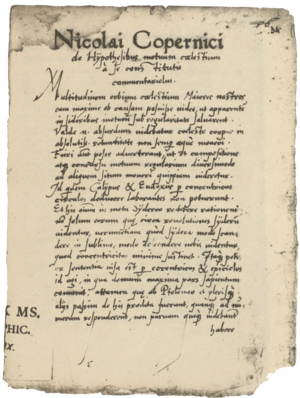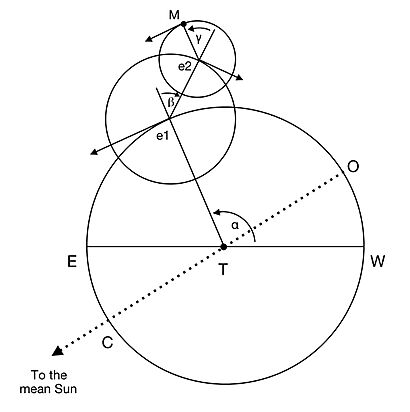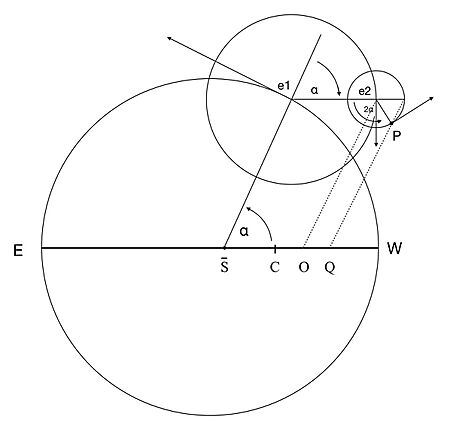Commentariolus facts for kids

Ms. Austrian National Library, 10530, f. 34r
|
|
| Author | Nicolaus Copernicus |
|---|---|
| Language | Latin |
| Subject | Astronomy |
|
Publication date
|
1514 |
The Commentariolus (which means Little Commentary in Latin) is a short book written by Nicolaus Copernicus. It was an early version of his amazing new idea about the universe. This idea is called the heliocentric theory. It says that the Sun is at the center of our solar system, and the Earth and other planets orbit around it. This was a big change from the old idea that Earth was the center.
Copernicus wrote the Commentariolus around 1514. He shared copies with his friends and other smart people. Even though it was never printed during his lifetime, many people learned about his ideas from it. Later, in 1543, Copernicus published his full and complete theory in a famous book called De revolutionibus orbium coelestium (On the Revolutions of the Heavenly Spheres).
In 1533, a scholar named Johann Albrecht Widmannstetter gave talks in Rome about Copernicus's theory. Even important people like Pope Clement VII and several Catholic cardinals listened and were interested. Years later, in 1536, a cardinal named Nikolaus von Schönberg wrote to Copernicus. He asked for a copy of his writings as soon as possible.
After Copernicus died, copies of the Commentariolus were still passed around for a while. But then, it was mostly forgotten. People only knew it existed because others had mentioned it. It wasn't until the late 1800s that a real copy was found and published. This helped people understand how Copernicus's ideas first developed.
What Did Copernicus Explain in the Commentariolus?
The Commentariolus has eight main parts. The first part is a short introduction. The other seven parts have titles that describe what they are about. In the first section, Copernicus listed seven important ideas. He used these ideas to show how the planets' movements could be explained in a new, organized way.
Copernicus's Seven Big Ideas
Here are the seven main ideas Copernicus presented in his Commentariolus:
- Not all objects in space orbit around a single point.
- The center of the Earth is where the Moon orbits.
- All the planets orbit around the Sun, which is close to the center of the universe.
- The distance between the Earth and the Sun is tiny compared to the distance to the stars. This is why we don't see the stars shift their positions as Earth moves (a phenomenon called parallax).
- The stars do not move. Their daily movement across the sky is caused by the Earth spinning each day.
- The Earth moves in a circle around the Sun. This causes the Sun to appear to move across the sky each year. The Earth also has more than one type of motion.
- The Earth's orbit around the Sun makes the other planets seem to move backward sometimes.
The other sections of the Commentariolus explained more details. They covered topics like "The order of the spheres," "The apparent motions of the Sun," "How to measure equal motion," "The Moon," "The outer planets: Saturn, Jupiter and Mars," "Venus," and "Mercury."
The Order of the Planets
In this part, Copernicus described the order of the planets and stars from the farthest out to the closest to the Sun. The outermost part was the sphere of the fixed stars, which he said stayed perfectly still. Inside that, he placed the spheres (or orbits) of Saturn, Jupiter, Mars, Earth, Venus, and Mercury. Each of these planets orbits the Sun from west to east. They also take different amounts of time to complete one orbit.
For example:
- Saturn takes about 29 to 30 years.
- Jupiter takes about 11 to 12 years.
- Mars takes about 2 to 3 years.
- Earth takes exactly one year.
- Venus takes about 8 to 9 months.
- Mercury takes about 2 to 3 months.
The Moon, however, orbits the Earth in about one month. It moves with the Earth as the Earth orbits the Sun.
How the Sun Appears to Move
This section explained why the Sun seems to move across the sky. Copernicus said this happens because of three separate motions of the Earth:
- The first motion is Earth's yearly trip around the Sun. This path is a circle, but its center is slightly off from the Sun's center.
- The second motion is Earth's daily spin. The Earth spins around an imaginary line (its axis) that goes through its center. This axis is tilted about 23.5 degrees compared to its orbit.
- The third motion is a slow wobble of Earth's axis. This wobble is called precession. It makes the Earth's axis point in slightly different directions over a very long time. This explains why the equinoxes (when day and night are equal) slowly shift over time.
Measuring Motion by Fixed Stars
Copernicus believed that the equinoxes and celestial poles (the points in the sky directly above Earth's poles) did not move at a steady rate. Because of this, he argued that they should not be used to measure the planets' movements. Instead, he said it was more accurate to measure planetary motions by looking at the fixed stars. He calculated that a sidereal year (the time it takes for Earth to complete one orbit relative to the stars) was always 365 days, 6 hours, and 10 minutes.
The Moon's Orbit
Copernicus explained the Moon's motion as a combination of five different movements. Besides orbiting the Sun with the Earth, the Moon also orbits the Earth. This orbit is tilted about 5 degrees compared to Earth's orbit around the Sun. This tilted path also slowly wobbles over about 18 to 19 years.
To explain the Moon's path more precisely, Copernicus used a system of circles within circles, called epicycles and deferents. Imagine a large circle (the deferent) around the Earth. A smaller circle (the first epicycle) moves along this large circle. Then, an even smaller circle (the second epicycle) moves along the first smaller circle. The Moon itself moves along this second, smallest circle. This complex system helped Copernicus explain the Moon's changing speed and apparent size as it orbits Earth.
The Outer Planets: Saturn, Jupiter, and Mars
Copernicus used a similar system of circles to explain the movements of the outer planets (Saturn, Jupiter, and Mars). Their orbits were not perfectly flat like Earth's, but they were only slightly tilted. Unlike the Moon's orbit, the tilt of these planets' orbits did not wobble.
Just like with the Moon, Copernicus used a main circle (deferent) and two smaller circles (epicycles) to show how these planets moved. The center of the first epicycle moved along the deferent. The center of the second epicycle moved along the first. The planet itself moved along the second epicycle. This method allowed Copernicus to explain the planets' observed paths without using a controversial idea from older theories called the equant. The equant was a point from which the planet's motion appeared uniform, but it was not the center of the orbit. Copernicus's system was more elegant because it used only uniform circular motions.
Venus and Mercury
In the last two sections, Copernicus discussed Venus and Mercury.
- Venus: He described Venus's orbit using a system of circles. Venus takes about 9 months to complete one orbit around the Sun.
- Mercury: Mercury's orbit is harder to study because it's only visible for a few days each year. Like Venus, Mercury's path was also explained using two epicycles. Mercury takes almost three months to complete its orbit around the Sun.
Rediscovering an Old Idea
The Commentariolus was a very important first step for Copernicus. It showed his early thoughts on a Sun-centered universe. Even though it was lost for a long time, its rediscovery helped historians understand how Copernicus developed his groundbreaking ideas that changed how we see our place in the universe.



